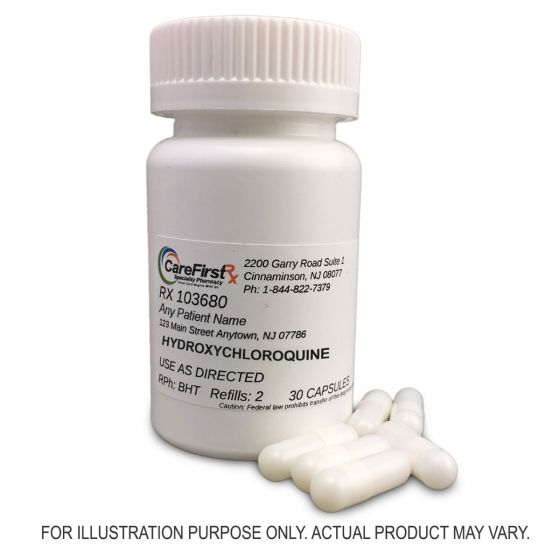Hydroxychloroquine Dispensing Guidelines
Hydroxychloroquine is an aminoquinoline/antimalarial agent used to treat Lupus, Rheumatoid Arthritis, and Malaria. It has off-label uses for dermatomyositis, porphyria cutanea tarda, primary Sjögren syndrome, Q fever, sarcoidosis, and most recently, COVID-19. With commercial dosage forms in short supply, compounding pharmacies can make hydroxychloroquine in a strength and dosage form that is appropriate for you.
Pronunciation
hye droks ee KLOR oh kwin
Brand Name:
Plaquenil
Drug Class:
Aminoquinoline/Antimalarial Agent
Mechanism of Action:
Hydroxychloroquine's mechanism of action is not fully understood, however, it has been shown to increase the intracellular pH and inhibit lysosomal activity in immune cells which is key in reducing T cell activation, differentiation and expression of costimulatory proteins and cytokines. Furthermore, hydroxychloroquine works to alter the pH of endosomes and interrupt binding between toll-like receptors and their RNA/DNA ligand which can suppress TLR signaling. In the cytoplasm, hydroxychloroquine can interfere with interactions between cytosolic DNA and the nucleic acid sensory cyclic GMP-AMP synthase. These pathways cumulatively affect subsequent pro-inflammatory signaling activation and cytokine production.
Drug Interactions:
Hydroxychloroquine can interact with many medications. Consult your physician if you are taking artemether, dapsone, lumefantrine, or mefloquine.
Talk to your doctor if you have:
Gastrointestinal disorders, hepatic impairment, porphyria, psoriasis or renal impairment
Adverse Effects:
Tell your doctor if you experience any of these symptoms following hydroxychloroquine administration:
- Liver problems like dark urine, abdominal pain, yellow skin or eyes
- Low blood sugar like dizziness, fatigue, shaking, fast heartbeat, confusion, or sweating
- Infection
- Vision changes
- Bruising or bleeding
- Unable to control eye movements or abnormal movements
- Seizures
- Mood changes, nightmares, thoughts of suicide
- Hearing loss, change in hearing, noise/ringing in ears, change in balance
- Tremors or muscle weakness
- Heart problems like abnormal heartbeat or shortness of breath
- Signs of a significant reaction
Administration/Dosing:
For treatment of Systemic Lupus and Rheumatoid Arthritis, dosing is 200-400 mg daily as a single dose or in 2 divided doses. Patients should not exceed >5 mg/kg/day using actual body weight. For treatment of malaria, dosing is 800 mg once, followed by 400 mg at 6, 24, and 48 hours after initial dose. For chemoprophylaxis of malaria, dosing is 400 mg once weekly on the same day each week; begin 1 to 2 weeks before travel to malarious area; continue therapy while in malarious area and for 4 weeks after leaving the area.
Pregnancy/Breastfeeding:
Hydroxychloroquine does not appear to pose significant risk to a fetus at lower doses. The CDC has stated that the malarial prophylactic dose of 400mg/week is safe. At higher doses for prolonged periods, there is increased fetal risk, though the magnitude is unknown. Daily amounts of hydroxychloroquine should be taken cautiously in breastfeeding woman because of the slow elimination rate and potential for accumulation of toxic amounts in the infant.
References:
- Devaux C, et al. International Journal of Antimicrobial Agents. 2020 Mar.
- Centers for Disease Control and Prevention (CDC). Guidelines for treatment of malaria in the United States. Updated April 1, 2019. Accessed August 15, 2019.
- Clarke J. Initial management of discoid lupus and subacute cutaneous lupus. Post TW, ed. UpToDate. Waltham, MA: UpToDate Inc. Accessed August 15, 2019.
- Committee on Drugs, American Academy of Pediatrics. The transfer of drugs and other chemicals into human milk. Pediatrics 2001;108:776–89.
- Hydroxychloroquine: from Lexicomp.com. Retrieved from https://online.lexi.com/hydroxychloroquine Accessed 4/6/2020
- Plaquenil (hydroxychloroquine) [prescribing information]. St. Michael, Barbados: Concordia Pharmaceuticals Inc; September 2019.
- Singh JA, et al. 2015 American College of Rheumatology guideline for the treatment of rheumatoid arthritis. Arthritis Rheumatol. 2016;68(1):1-26.
- Zhou D, et al. Journal of Antimicrobial Chemotherapy. 2020 Mar.




